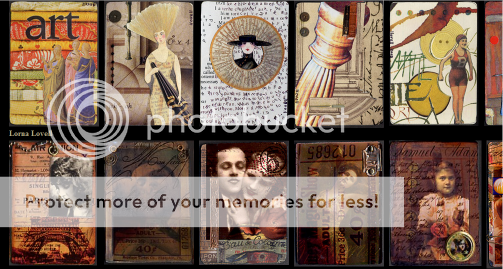|
|
|
|
|
|
|
|
|
 Posted: Tue May 05, 2009 1:51 pm Posted: Tue May 05, 2009 1:51 pm
ATC – ARTIST TRADING CARDS (see examples at bottom of the thread...)
History
Artist Trading Cards (or ATCs) are miniature works of art about the same size as baseball cards[1] and thin enough to fit inside standard card-collector pockets, sleeves or sheets.[2] The ATC movement developed out of the mail art movement and has its origin in Switzerland.[3] The cards are usually traded or exchanged rather than sold.
M. Vänçi Stirnemann originated the idea in 1996,[4] holding trading sessions in Zurich, Switzerland.
Clubs and trading sessions have largely replaced the original concept of trading the cards during individual encounters, and many ATC workshops end with a trading session.
|
 |
 |
|
|
|
|
|
|
|
|
|
|
|
|
 Posted: Tue May 05, 2009 1:54 pm Posted: Tue May 05, 2009 1:54 pm
HOW TO MAKE ATC’S
Rules
There are some rules to trading artist cards. Artist trading cards are pieces of watercolor paper, cardstock, or illustration board that are 2.5"x3.5" in size. Or 6.4cm x 8.9cm.
An artist creates an original work of art on these tiny canvases and then trades them with other artists through groups and events. Trade is the operative word. Cards should not be sold.
Any medium is allowed on trading cards. Some examples of mediums that other artists have used is crayon, wax reserve, collage, gel pens, concrete transfers, watercolor, colored pencil, and pencil sketchings.
On the back of the cards, the artist should print their name, contact information (an email address is fine), the title of the work on the artist trading card, and a number if it is part of a series.
How To:
ATCs can either be bought pre-made or can be made from larger sheets of paper cut down to size.
Strathmore has a line of quality, pre-made blank artist trading cards that comes in packs of 5 to 20 sheets. These cards come in 100 lb. bristol, canvas paper, 140 lb. watercolor paper, 246 linen paper for acrylics, 80 lb. textured paper, 42 pt. illustration board, and assorted packs. Strathmore also has envelopes for mailing individual cards.
To make cards, the artist should decide on what type of paper she will need for the medium she uses. The paper will also need to be durable to stand up to any handling it may receive. A soft pencil should be used to mark the dimensions of the card so that the paper will not be damaged. A mat knife works well to cut the paper. The artist may want to hold a ruler along the edge of the pencil marks to guide the blade for a straighter cut.
|
 |
 |
|
|
|
|
|
|
|
|
|
|
|
|
|
|
|
 Posted: Tue May 05, 2009 7:27 pm Posted: Tue May 05, 2009 7:27 pm
How to continued......(computer generated ATC's)
There are very few rules for creating your own Artist Trading Card. One rule is the standard size of 2 1/2 by 3 1/2 inches. Also, the ATC should be one of a kind or limited editions. Traditionally, the Artist Trading Card has always been freely traded and it is frowned upon to sale them. Of course, you would want to sign and date the back. If you like, you could also give the card a title and add further contact information. You can make your Artist Trading Card using any media including your computer. This would be a great project for PhotoshopR, PainterR and Paint Shop ProR users.
So how would you begin to make your very own Artist Trading Card? If it will be printed, you will want it to be at least 300 dpi or use 72 resolution for the web. So you would start with a blank project that is 2 1/2 x 3 1/2 inches (1050 x 750 pixels) and 300 dpi. If you want to print your card on an inkjet printer or share it on the web, you can set the Color Mode to RGB. If you will be taking your card to a professional printer, use CMYK. After that, the sky is the limit. Just have fun. Here are some ideas. If you are already digital scrapbooking in PhotoshopR or Paint Shop ProR, you could make a miniature scrapbook page. If you like to use PainterR, why not make your own miniature Van Gogh.
ATCs have just one simple rule: they must measure 2-1/2 x 3-1/2 inches, and be flat enough to slide into a standard trading card sleeve. Media, materials, and techniques are totally up to the individual artist, so cards can be rubber stamped, painted, collaged, screen-printed, or created by any method imaginable. ATCs are ideal for those who like small, quick projects, for testing new techniques, trying out new rubber stamps, or just playing. I generally make mine when I’ve got an idea for a collage or altered book page, and want to see how ink colors, papers and stamp designs look together. The materials are already out on the table and messy, so why not make a dozen ATCs while I’m at it? It’s an easy habit to fall into.
ATC examples are not easy to find, but there are a few artists sharing their work online. Art In Your Pocket offers photos of ATCs from a variety of artists active at Nervousness. Empress Dragon provides art galleries filled with ATC work, and also some great tips and templates for those wanting to get started. Both sites offer lists of links to other ATC artist web sites. I also have a few examples of ATCs posted in my own online gallery.
Places to swap ATCs can be equally elusive unless you’re already involved in some type of mail art. For the newcomer, the easiest place to find other ATC enthusiasts is Nervousness, home of all types of interesting land mail art objects. For rubber stamp enthusiasts, there is ArtTradingCards at Yahoo. For those who are patient and brave, there’s Copy Left, which collects cards until there are enough to make an edition, and then mails them back.
A few ATC tips:
• The back of your cards should contain your name, any contact information
you wish to provide, and the number or series of the card. Some artists start numbering their cards with number 1, and just keep going. Others will do series numbering, such as 1 of 7 or 1/7. How you number is totally up to you.
• Dimensional embellishment is acceptable, but remember that your finished card must fit into a standard trading card sleeve. Making cards larger than the established dimensions is poor form, and will make your cards less desirable when swapping.
• When choosing stamps and collage materials, remember to scale everything down a little. The small size of an ATC lends itself to smaller designs that might get lost in larger collages or altered books. Save your littlest items for your ATCs
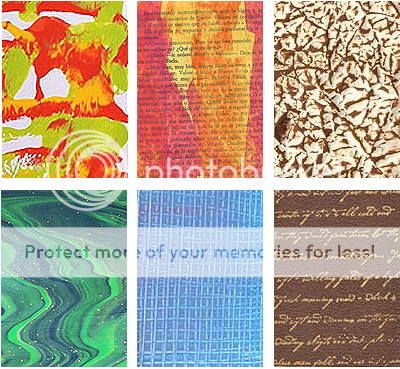
First, we’ll need some backgrounds. Backgrounds are just what they sound like—something that acts as a surface on which to build your layers. ATC backgrounds can be made of pretty much anything you choose. I generally start with a plain piece of cardstock cut to size (2-1/2 x 3-1/2 inches), and build up. Here’s an assortment of patterned papers, painted text pages, clay tiles and whatever else was laying around on my work table:
Notice there are no solid backgrounds here? That’s intentional. Just because it’s a background doesn’t mean it has to be boring!
Sometimes, those basic backgrounds need something, because let’s face it—starting out with just a piece of paper isn’t very exciting.
Let’s make some of these basic backgrounds a little more interesting:
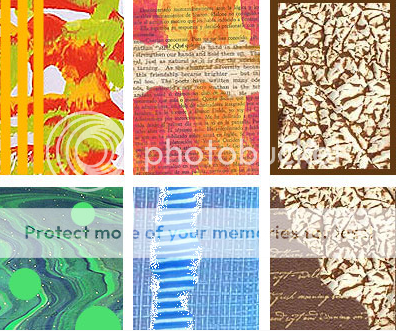
Top left: added three strips of yellow cardstock.
Top center: added one torn strip of lighter text. Notice on both of these first two cards that the additions don’t split the card into two even halves, but into two different sized sections? Most people’s eyes will accept more easily than an exact split in half.
Top right: On a lightweight background paper you can trim them down slightly smaller, and mount them on a solid color cardstock to create a frame.
Bottom left: added three dots, just to break up the design a bit.
Bottom center: added a torn piece of blue, set to one side of the card.
Bottom right: added a torn piece of lighter paper to the top right corner.
OK, now we have some interesting backgrounds—next come focal images. A focal image is the main image that draws the eye. It’s the thing the viewer should see first. In most collaged cards, it’s a person or thing, so let’s try a few people and things:
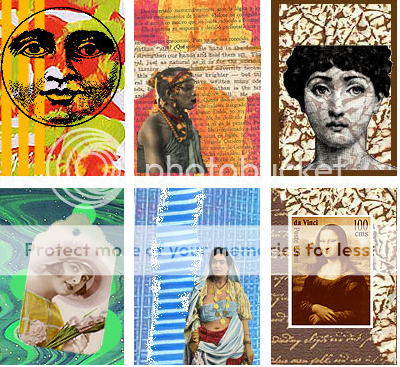
This can be an image rubber stamped directly onto the card like the one at upper left, or stamped onto a transparent paper like the one at upper right. You can use printed images of people that have been cut away from their backgrounds, like the two center cards. You can also grab an image on a tag, and one on a faux postage stamp, because focal points can always be things like tags, stamps or other applied pieces. The one thing all these images have in common is that they’re fairly large on the cards, and on each card, there is only one. Pick one big thing to take focus rather than choosing a bunch of little things.
Now it’s time to embellish the card. This is where a lot of people dump everything in their junk drawer onto the card. Try to pick one or two things—or one thing that you can use several times:
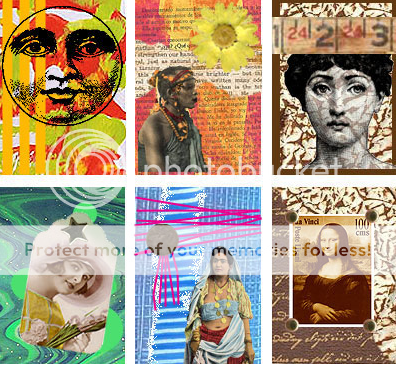
The key to embellishing is to make sure that whatever you choose is smaller than the focal image, and doesn’t obscure it in any way. So, starting at the top left, the moon face was left unembellished, because that card is already has more than enough stuff going on. Top center, the African girl in one corner gets balanced out by a big yellow daisy in the opposite corner. The stamped image at top right got a strip of measuring tape placed to keep me from wondering where the top of her head went. Lower left, the tag needed a brad in its little hole, and a star shape just for fun. This image is large enough that it doesn’t need much more. Center, the card was wrapped with magenta fibers tied in a knot, and a small coin. Right, added four small brads to the corners of the stamp.
You may like to use words on of your ATCs, so the very last step is to add a word in a convenient empty spot:
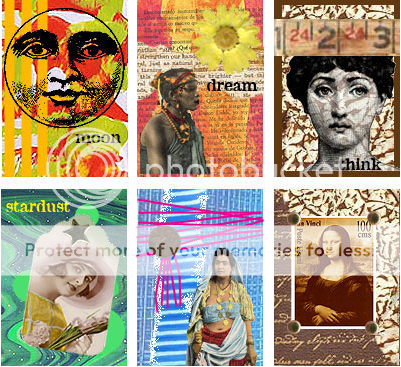
There ya go—finished ATCs in just a few easy steps!
(No paper was harmed in the creation of this lesson. These cards were all created digitally!)
|
 |
 |
|
|
|
|
|
|
|
|
|
|
|
|
 Posted: Tue May 05, 2009 7:37 pm Posted: Tue May 05, 2009 7:37 pm
Protecting Cards
Once the artist has trading cards, he will want to protect them. The card may need to be treated with fixative if the medium is unstable. Pastels, charcoal, and pencil fall under this category.
Art trading cards can be protected using sports card binders, plastic sheets, and organizers. Many hobby shops carry these.
|
 |
 |
|
|
|
|
|
|
|
|
|
|
|
|
|
|
|
 Posted: Tue May 05, 2009 7:39 pm Posted: Tue May 05, 2009 7:39 pm
Trading
There many groups and sponsors, both online and off, that artist can use to trade their art cards.
The Yahoo Artist Trading Card Group has more than 3,000 members that trade cards and share their love for the art form.
ATCsForAll.com is a website that allows its members to trade, enter ATC contests, and more.
Strathmore Artist Papers hosts a global artist trading card swap where artists are encouraged to send in a card to receive a card from around the world in return. The entry form can be downloaded from the following website:
http://www.strathmoreartist.com/images/holiday_swap/sap_atcswap_entry.pdf
ArtistTradingCards.Meetup.com is website designed to help artists find local art card trading groups. Visitors can type in their zip code to easily locate groups.
Even if the artist isn’t ready to trade cards, the members of these groups and sponsors can enlighten and inspire the artist in many ways.
WEBSITES AND LINKS FOR ATC INFORMATION AND TRADING INFORMATION:
http://painting.suite101.com/article.cfm/artist_trading_cards
http://www.art-e-zine.co.uk/atcnov03.html
http://www.artist-trading-cards.ch/history.html
http://www.richmondartgallery.org/atc.php
http://www.facebook.com/group.php?gid=9104983993
http://groups.yahoo.com/group/artisttradingcards/
IF YOU ARE INTERESTED IN SETTING UP A TRADING CLUB HERE IN SYSTEM ERROR SEND ME A PM.
|
 |
 |
|
|
|
|
|
|
|
|
|
|
|
|
 Posted: Tue May 05, 2009 7:47 pm Posted: Tue May 05, 2009 7:47 pm
|
|
|
|
|
|
|
|
|
|
|
|
|
 Posted: Tue May 05, 2009 8:34 pm Posted: Tue May 05, 2009 8:34 pm
ooooooohhhhh. O.O That looooksss neeeeeatt.
eek eek eek eek eek
|
 |
 |
|
|
|
|
|
|
|
|
|
|
|
|
 Posted: Thu May 07, 2009 12:14 pm Posted: Thu May 07, 2009 12:14 pm
Oh wow I was never aware of this concept.
I make collages all the time and limiting myself to trading card sized wouldn't inhibit me all that much. Hmm... I'm pretty sure I'll be getting into this.
You know.. that would be AWESOME if we could swing a System Error swap of ATCs. Count me in Fire!!!
|
 |
 |
|
|
|
|
|
|
|
|
|
|
|
|
|
|
|
 Posted: Thu May 07, 2009 12:20 pm Posted: Thu May 07, 2009 12:20 pm
I'm gathering materials for my first one right now. Really, really want to exchange with guild members.
|
 |
 |
|
|
|
|
|
|
|
|
|
|
|
|
 Posted: Fri May 08, 2009 2:30 am Posted: Fri May 08, 2009 2:30 am
Wicked Lilith Thing I'm gathering materials for my first one right now. Really, really want to exchange with guild members.
I was hoping someone else would be into it.... hmmm... I will put the thinking cap on as to how we can set up a swap club and let you know...... Im wanting to do that to!
|
 |
 |
|
|
|
|
|
|
|
|
|
|
|
|
|
|
|
 Posted: Sun May 10, 2009 4:53 am Posted: Sun May 10, 2009 4:53 am
bounceybouncey
This is so much fun. I can't wait to start exchanging cards.
|
 |
 |
|
|
|
|
|
|
|
|
|
|
|
|
 Posted: Sun May 10, 2009 4:56 am Posted: Sun May 10, 2009 4:56 am
Quote: No paper was harmed in the creation of this lesson. These cards were all created digitally!) LOTS of paper will be harmed in the creation of my cards mwah-ha-ha but it's all reuse of magazines and newspapers that would have otherwise been recycled.
|
 |
 |
|
|
|
|
|
|
|
|
|
|
|
|
|
|
|
 Posted: Wed Jul 15, 2009 1:54 pm Posted: Wed Jul 15, 2009 1:54 pm
Oh hey, I know about these!
My mom got into them a couple of years ago.
I've only ever made a couple of the digitally, but I'd love to get into doing handmade ones.
I'd be up for a swap!!
Very.Slowly.Dying.
|
 |
 |
|
|
|
|
|
|
|
|
|
|
|
|
 Posted: Thu Oct 29, 2009 9:30 am Posted: Thu Oct 29, 2009 9:30 am
Hey hey.. any new news on this?
|
 |
 |
|
|
|
|
|
|
|
|
|
 |
|
|
|
|
|
|








